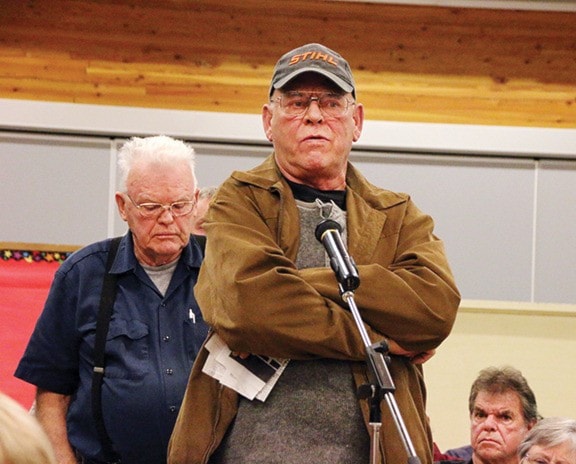A large and angry crowd turned out at the Cowichan Lake Sports Arena to grill regional representatives about recently announced bylaws and the controversial Alternative Approval process being used to push them through.
The Cowichan Valley Regional District’s CEO Brian Carruthers took most of the heat as he answered questions about the AAP, which requires 10 per cent of an electorate to quash a bylaw by sending in ‘no’ ballots, and also about the arts and culture and flood management bylaws.
Honeymoon Bay director Ian Morrison quarterbacked the event and regional district heavyweights Kate Miller and John Elzinga were also on hand to introduce the bylaws.
The audience included residents from Lake Cowichan, Youbou, Honeymoon Bay and Sahtlam, along with observers and politicians from all around the Cowichan Valley.
Although questions ranged all over the place, it soon became clear that no one, including regional directors and staff, like the AAP.
Carruthers reiterated many times throughout the two-hour session that if enough people express their opposition, the bylaws cannot go through. He also urged several people who wanted to talk about Catalyst and their weir application to attend a session scheduled by that company on the following evening.
One man asked which administrative body would be in charge when such diverse groups as North Cowichan, Duncan, Cowichan Tribes and the CVRD were involved. Another said that having North Cowichan’s mayor, Jon Lefebure, at the head of the CVRD board led to a conflict of interest.
Still another said that if AAPs can be used so easily, then voters should be able to use that process to recall their director.
Others, who said they didn’t live on their Cowichan Lake property in winter, asked for better notification about the AAP, since they don’t get Valley papers where they live.
Several times throughout the evening, Carruthers explained that the regional district has only two choices when dealing with things they want to do. They can either go to a referendum, which can cost up to $100,000, or they can use the AAP. By law, they have no other choices.
One person said that the maps on the CVRD website made it hard to understand who was affected by the flood management bylaw and who was not.
Carruthers said that, because the area chosen was the Cowichan River watershed, it’s not always easy to show on the map.
Another often repeated question was: “Why am I, as a Lake Cowichan resident, being asked to pay for dams in the delta area?”
The CEO had his work cut out on that one, given the groans from the audience, but he tried to convince them that, “It’s a collective process, it’s about community. You may not all benefit directly but the schools and businesses you go to may benefit.”
People who tried to make practical suggestions for raising money, like Honymoon Bay’s John Harmon, who suggested charging Catalyst and others for consumption of water from Cowichan Lake, got an unpalatable answer.
“The province doesn’t allow us to tax people for the use of water,” Carruthers said.
He also urged people to fill in forms if they opposed the bylaws.
“This is democratic. You do have a say. We just want you to decide with all the information. We think an ounce of prevention is worth a pound of cure, but if you don’t agree, the forms are here. If you don’t want to pay [for a proposed function], you can vote ‘no.’”
Several property owners from Youbou to Sahtlam were concerned about silt and gravel in the river, some expressing concern that it was increasing and others asking why the CVRD was talking about removing gravel from the lower river when they can’t even cut the lawn near the water’s edge on their riverfront property at the upper end. Still others complained about differing requirements on construction, with at least one person noting that the runoff from Cowichan Commons mall was another spanner tossed in the works.
Miller tried to address some of these, pointing out that not only is climate change affecting how often floods occur and their magnitude, there is actually a lot of gravel — more than 18,000 cu. metres — moving down the river annually now.
Lorne Scheffer of Meade Creek appeared to speak for many when he urged regional officials to have the courage of their convictions.
“Put it to the taxpayer. If you really believe in these things, put them to referendum,” he said.
